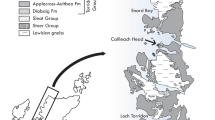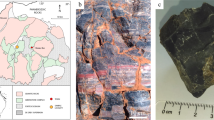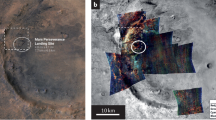Abstract
Bridgwater et al.1 issued a ‘cautionary note’ concerning several reports published by Pflug and co-workers2–5 describing objects called yeast-like microfossils (Isuasphaera isua Pflug) from a metamorphosed quartzite of the 3,800-Myr-old Isua supracrustal belt of south-west Greenland; Bridgwater et al. believe that the objects described by Pflug et al.2–5 are ‘indistinguishable from limonite-stained fluid inclusions’ and hence are non-biogenic. I show here that the objects are neither limonite-stained fluid inclusions nor microfossils, but are limonite-stained cavities from the otherwise complete dissolution by weathering of ferruginous dolomite grains in these rocks. Several supporting arguments presented by both sides are believed to be invalid, and others are ambiguous. In view of the extensive research on the earliest life forms, and then significance to evolution, to early geochemical cycles and to the origin of the atmosphere and some ore deposits, the exact nature of the Isua objects, and particularly the validity of the evidence either for or against a biological origin, are of considerable importance. A careful evaluation of the evidence from Isua is particularly pertinent, as bona fide Precambrian fossils are also found in chemically similar (but much younger) silica-rich environments.
This is a preview of subscription content, access via your institution
Access options
Subscribe to this journal
Receive 51 print issues and online access
$199.00 per year
only $3.90 per issue
Buy this article
- Purchase on Springer Link
- Instant access to full article PDF
Prices may be subject to local taxes which are calculated during checkout
Similar content being viewed by others
References
Bridgwater, D. et al. Nature 289, 51–53 (1981).
Pflug, H. D. Naturwissenschaften 65, 611–615 (1978).
Pflug, H. D. Oberhess. naturw. Z. 44, 131–145 (1978).
Pflug, H. D. & Jaeschke-Boyer, H. Nature 280, 483–486 (1979).
Pflug, H. D., Jaeschke-Boyer, H. & Sattler, E. L. Microscopica Acta 82, 255–266 (1979).
Cloud, P. E., Jr, Licari, G. R., Wright, L. A. & Troxel, B. W. Proc. natn. Acad. Sci. U.S.A. 62, 623–630 (1969).
Horodyski, R. J. & Donaldson, J. A. Precambr. Res. 11, 125–159 (1980).
Nagy, L. A. Grana 11, 91–94 (1971).
Schopf, J. W. J. Paleontol. 42, 651–688 (1968).
Schopf, J. W. & Prasad, K. N. Precambr. Res. 6, 347–366 (1978).
Skippen, G. B. J. Geol. 79, 457–481 (1971).
Rosenfeld, J. L. Spec. Pap. geol. Soc. Am. 129 (1970).
Forsman, J. P. in Organic Geochemistry (ed. Breger, I. A.) 148–182 (Macmillan, New York, 1963).
Roedder, E. Scient. Am. 207, 38–47 (1962).
Francis, S., Margulis, L. & Barghoorn, E. S. Precamb. Res. 6, 65–100 (1978).
Schopf, J. W. Ann. Rev. Earth planet. Sci. 3, 213–249 (1975).
Walters, C. et al. Abstr. Div. Geochem. Am. chem. Soc. 178th a. Meet. (Washington, 1979).
Schidlowski, M., Appel, P. W. U., Eichman, R. & Junge, C. E. Geochim. cosmochim. Acta 43, 189–199 (1979).
Cecil, C. B., Stanton, R. W., Dulong, F. T. & Cohen, A. D. Okefenokee Swamp: Its Natural History, Geology and Geochemistry (Wetlands Surveys, Inc., Columbia, in the press).
Author information
Authors and Affiliations
Rights and permissions
About this article
Cite this article
Roedder, E. Are the 3,800-Myr-old Isua objects microfossils, limonite-stained fluid inclusions, or neither?. Nature 293, 459–462 (1981). https://doi.org/10.1038/293459a0
Issue Date:
DOI: https://doi.org/10.1038/293459a0
This article is cited by
-
Age of the oldest rocks with biogenic components
Journal of Biological Physics (1995)
-
Inorganic self-organisation in precambrian cherts
Origins of life and evolution of the biosphere (1994)
-
A 3,800-million-year isotopic record of life from carbon in sedimentary rocks
Nature (1988)
Comments
By submitting a comment you agree to abide by our Terms and Community Guidelines. If you find something abusive or that does not comply with our terms or guidelines please flag it as inappropriate.



